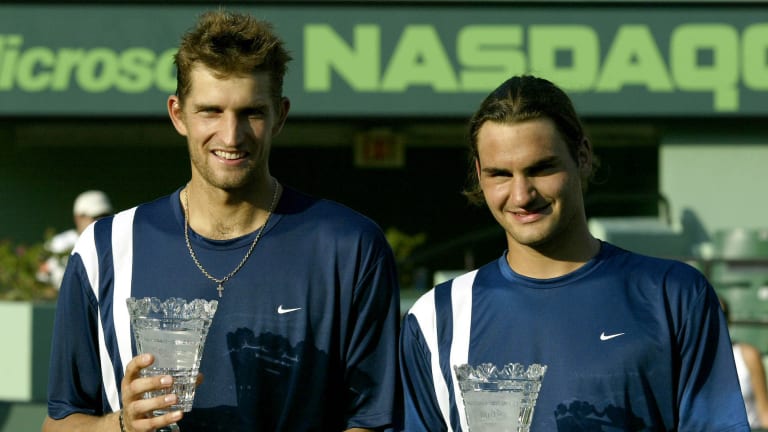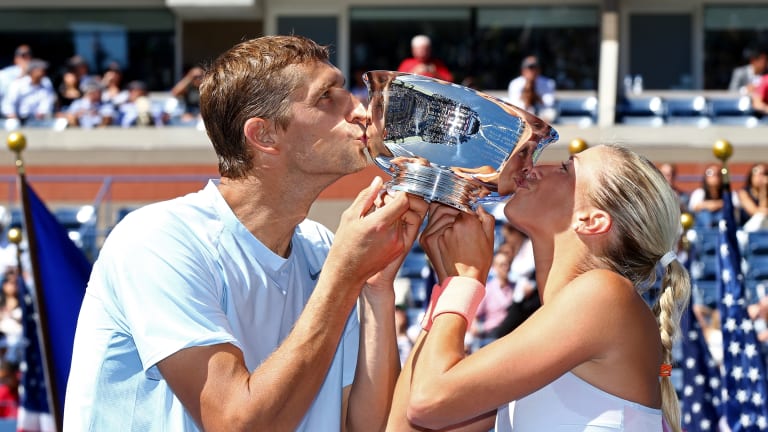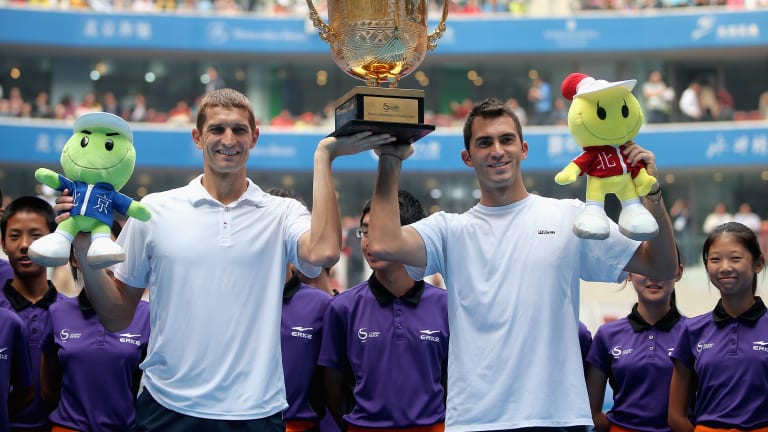Court Report: Roger Federer, Rafael Nadal, and Novak Djokovic look ahead to 2019
Mirnyi leaves the game with no regrets after competing for 22 years
By Steve Flink Dec 06, 2018Style Points
Emma Raducanu carries BJK Cup momentum—and Team GB's lucky bracelet—into Stuttgart quarterfinals
By Baseline Staff Apr 18, 2024ATP Bucharest, Romania
Joao Fonseca adjusts to heavier conditions in Bucharest for second ATP quarterfinal of 2024
By TENNIS.com Apr 18, 2024ATP Barcelona, Spain
Casper Ruud beats Jordan Thompson for tour-leading 26th win, reaches Barcelona quarterfinals
By Associated Press Apr 18, 2024WTA Stuttgart, Germany
Iga Swiatek slides through clay-court opener, defeats Elise Mertens in Stuttgart
By David Kane Apr 18, 2024WTA Stuttgart, Germany
Elena Rybakina, Marketa Vondrousova into Stuttgart quarters, Ons Jabeur out
By Associated Press Apr 18, 2024ATP Munich, Germany
Holger Rune makes it through rain, snow, hail, Galán in Munich return
By David Kane Apr 18, 2024Stat of the Day
Casper Ruud has now won more matches than anyone this year after latest win in Barcelona
By John Berkok Apr 18, 2024Style Points
As inseams get higher, Aryna Sabalenka, Stefanos Tsitsipas lead the Great Shorts Debate 🩳
By David Kane Apr 18, 2024ATP Barcelona, Spain
Cameron Norrie clinches 200th match win by halting Roberto Bautista Agut in Barcelona
By TENNIS.com Apr 18, 2024Mirnyi leaves the game with no regrets after competing for 22 years
Published Dec 06, 2018
Advertising
When Max Mirnyi recently retired from professional tennis at the age of 41, this towering figure from Belarus left with no regrets whatsoever. He had been out there competing honorably across 22 seasons, winning no fewer than 52 doubles tournaments on the ATP World Tour, taking six majors in men’s doubles and four more in mixed, claiming his first doubles title in 1997 and his last earlier this year.
He garnered the No. 1 world ranking in doubles for the first time in June of 2003, and resided there for 57 total weeks. But he also climbed to a career high of No. 18 in singles 15 years ago, establishing himself as one of only nineteen men to become a top 20 performer in singles in addition to reaching the very top in doubles. That, of course, was no mean feat.
And yet, Mirnyi has so many more credits in his victory column, including 16 Masters 1000 doubles crowns. He secured an astounding 1,024 match victories combined in singles and doubles, maintained a top 100 doubles ranking for twenty years in a row, was a stalwart Davis Cup player for Belarus, and proudly represented his country at the Olympic Games five times—taking a gold medal in mixed doubles with Victoria Azarenka in 2012.
During a wide ranging interview I conducted with Mirnyi, he spoke passionately about his multitude of opportunities and his philosophically approach to his line of work. He commenced our discussion by talking about the long process of electing to put the racket down for good.
“It kind of kept going in fluctuation,” said Mirnyi of retirement. “In our sport, obviously the decision is driven by the results. I played my last singles matches in 2009 and that was a tough time for me in a transition period, not knowing how I was going to fit into a doubles only career. So, starting with 2009 I was mentally ready that retirement could happen at any moment. I would not have known I would play for ten more years. If someone had told me that in 2009, I would definitely have said no way.”
Advertising

Mirnyi leaves the game with no regrets after competing for 22 years
© AFP/Getty Images
Could Mirnyi have envisioned back at the start of his journey that he would stretch it out for so long, succeed at the highest levels of the game for more than two decades, and still be winning tournaments this year?
“Definitely not,” he responds. “I could not have thought it would last this long for me. I had my first big results in 1997 and was listed as a professional on the ATP website in 1994 or 1995, but I felt from the time I was a 6-year-old that I was a professional already. I was never taking anything for granted in my career and I would feel like ‘Oh, wow, I have survived another year in a very competitive sport.’ And I was seeing all these superstars of past generations right in front of my face in the locker rooms, looking at the Becker’s and the Edberg’s, Agassi, Sampras, Chang and Martin. And then I was trying to learn about the young guys like Guga Kuerten and Roddick, Hewitt and Safin. I saw them all excel and advance to No. 1 in the world in my time. Then when Roger, Rafa, Djokovic and Murray came along, I totally thought I was done. But before I knew it I was around them for ten years. It was incredible and fascinating for me. Now I am kind of rolling back the memories and enjoying every bit of it.”
What stood out above all else about Mirnyi was his propensity to win with all kinds of partners. He had four different partners among the men (Hewitt, Mahesh Bhupathi, Jonas Bjorkman and Daniel Nestor) with whom he won majors, and three different women (Serena Williams, Azarenka and Andrea Hlavackova).
Speaking of his flexibility as a partner, Mirnyi modestly explains, “I always felt I had to adapt to my partner and never felt I was above them game-wise. I always saw it as a team effort of putting in the work and blending together. I never felt I was better than any of my partners. I had to work into their strengths and apply my own. Looking back I was able to play with a lot of lefties, righties, deuce and ad court players. With them all, I had no ego in terms of covering up something I did not feel comfortable doing. I was always open with my partners.”
One of those partners happened to be Roger Federer. They secured three titles together, winning Rotterdam and Moscow in 2002 and Miami the following year. He recalls, “Roger was on his way up to the domination he would establish for about five or six years when nobody could touch him. We hardly lost together. It was incredible to be on the same side of the court with him. He was breathing in confidence that he would project on every point. He felt that the bigger the moment, the more he could produce. It was a big luxury to play with him.”
Advertising

Mirnyi leaves the game with no regrets after competing for 22 years
© Getty Images
Mirnyi had a similarly renowned partner in Serena Williams during the summer of 1998, when Serena was only 16. They won Wimbledon and the US Open. Twenty years later, what does Mirnyi recollect about the experience?
“One thing definitely stood out about Serena,” asserts Mirnyi. “It was her physical presence. When we teamed up that summer of 98’ she had so much hunger and determination that any time she had her racket on the ball, I felt that our opponents—particularly the girls—were taking a step back on the other side. Serena’s power was already amazing, but I just felt maybe she could put a control clamp on it. Sometimes the errors were mounting and her shots were not just a foot out. I had no idea that she would dominate the world for such a long time but I could definitely sense her superior physical talent on the court even at that age.”
The Belarusian himself was ever daunting for adversaries with his physicality. He stood at 6’5”, officially weighed in at 200 pounds, and was never afraid to confront those with larger reputations. That was why he spent six consecutive years (2000-2005) among the top 50 in the world as a singles competitor, and his healthy sense of self helped him reach the final of Stuttgart in 2001 with wins over Gustavo Kuerten, Pete Sampras, Goran Ivanisevic and Yevgeny Kafelnikov. Moreover, he upended Federer and Kafelnikov, among others, to win Rotterdam in 2003. In 2002, he had his finest major in singles at the US Open, toppling Federer on his way to a quarterfinal loss to Andre Agassi.
As Mirnyi remembers, “I felt I almost did somewhat better playing against some of those top players because I had nothing to lose. The tennis that I was bringing to the court was causing some discomfort to those guys because I never gave the opposition much rhythm. I was an attacking player serving well, and that is how I approached my singles play. Indoors I felt I could dominate even more with my serve. My father would always say, ‘No sun, no wind, so go for your serve.’ That kind of stuck with me throughout my career.”
Turning his attention to his run to the last eight of the US Open sixteen years ago, Mirnyi recalls of his win over Federer, “I had already won a Grand Slam doubles title with Lleyton a few years earlier at the US Open so I was not intimidated by Roger. My game matched up well against his at the time. I powered through him and he did not present too much trouble for me with his returning games. I was fortunate to win that match and then it was incredible to watch what Roger was able to produce after that.”
Advertising

Mirnyi leaves the game with no regrets after competing for 22 years
© 2013 Getty Images
Of his four-set loss to Agassi in New York, Mirnyi recollects, “That match stands out for me. I have watched the video many times and can still see that volley I missed in front of my face when I was up a set and it was 1-1 or 2-2 in the second set with Andre serving at 15-40. He was the toughest player for me to face, not only in an official match. He was also the most intense practice partner I ever had. Whatever Andre was bringing in his bag was a lot of magic, not only as a tennis player but as a person.”
Mirnyi was a remarkable person himself, and a standout competitor. He carried a nickname through much of his career as “The Beast.” I wondered how that label came into view. He explained that it first surfaced in 1996 or 1997 when he was competing in Challengers with Alex Reichel, an older American player who was a buddy. They were playing in Vietnam in horrendous conditions, and Mirnyi won a few matches before losing to Fernando Vicente in a final set tiebreak.
The former No. 1 doubles player was soaked through and through. Reichel turned to him and said, “Max, you are The Beast. It doesn’t matter whether you won or lost. What matters is the way you fought.’”
The following day, Reichel was saying to fellow players, “Did you see ‘The Beast” play?” The nickname started to take hold after that.
But perhaps it was not until 2001 that it became permanent. Mirnyi played the US Open mixed doubles that year with none other than Anna Kournikova, and they reached the final. One day at a press conference during that event, a writer said, “Oh, you two are the perfect Beauty and the Beast match.”
As Mirnyi sums it up, “After we lost in that final I wasn’t sure if people were referring to the guy who fought hard on the court and gives everything, or if they wondering who was joining the beast as the beauty on the mixed doubles court. I continued to fight on the court. But also played a lot of mixed doubles not with Kournikova anymore but with Maria Sharapova, Martina Navratilova and Victoria Azarenka and others. So I had a lot of beauties on my half of the court in mixed doubles. In my mind the beauty and the beast title stands quite rightfully as they recognize me as the beast.”
He was, of course, so much more than that. And while his playing days are over, Mirnyi is moving on seamlessly to other professional endeavors. He has already opened the Max Mirnyi Sports Center in Belarus, boosted immeasurably by the help of his father. Although Max will still live with his family in Florida, he will return regularly to Minsk to work at the facility bearing his name. As he says, “It is not like a boarding academy where students come and stay but we do have a specialized tennis school there.”
Advertising

Mirnyi leaves the game with no regrets after competing for 22 years
© 2013 Getty Images
Perhaps he will eventually work out an additional professional home for himself at IMG Academy in Bradenton, Florida, where he trained for the bulk of his playing career. As Mirnyi puts it, “IMG has always been supportive of me over the years. I have always enjoyed practicing with the juniors there. I have no official role with IMG now but possibly in the future it might be a good opportunity.”
For the time being, however, he can pause briefly to digest all that he has done. Many former and current players—including Brad Gilbert and Kevin Anderson—have been in touch with Mirnyi to express their gratitude for his contributions to the game. Others will inevitably follow with their appreciation for the man.
Meanwhile, Mirnyi alerted not only the President of his tennis federation back home about his retirement but also was in touch with the office of the President of Belarus, Alexander Lukashenko.
“I explained why I came to this decision,” says Mirnyi. “It had been anticipated for many years back home but the people I spoke to at our federation and in President Lukashenko’s office were sending me nice regards. They know I am looking forward to expanding my horizons.”
Having accomplished so surpassingly and celebrated such an extraordinary career, how does Mirnyi assess his legacy?
He replied, “I don’t really want to make a big deal about myself. I am proud that I was able to live through it for almost a quarter of a century if you count my first Davis Cup tie in 1994. I believe I have made my family proud and others proud. I am grateful to have been a part of the ATP Tour and thankful to the ITF for having me as part of their historic events. I feel my legacy should stand as this one guy who loved to play the game and worked hard at it and had a good career. But now he is around to help other to progress and be useful to the game of tennis in the years ahead.”